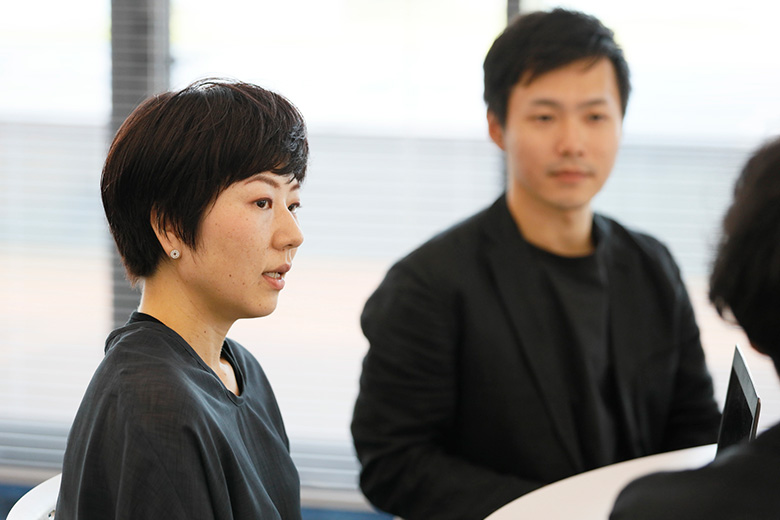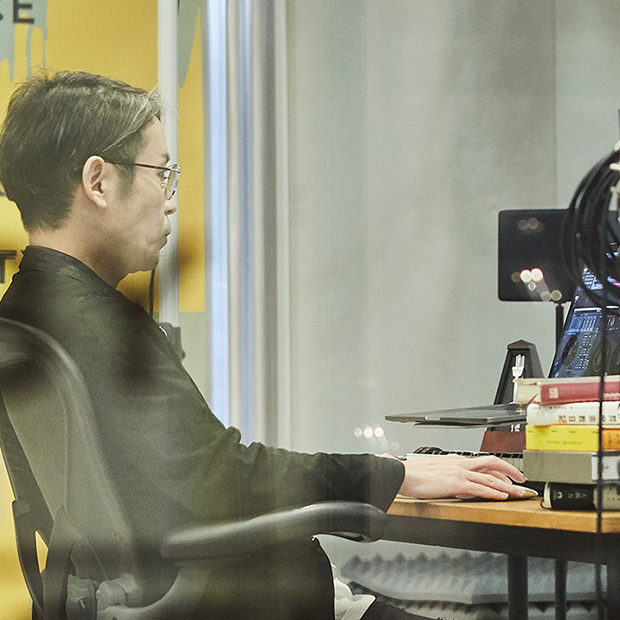The three young designers—Daichi Yamaguchi from Takenaka Corporation and Daikin product designers Mana Yamashita and Takaaki Sanagi—exchanged views in a special talk about changes in the role of designers. In Part 2, they elaborated on their method for collecting information and thought process.

Information as “points”
Sanagi:
When I started working, I felt something missing in my work. In hindsight, it may have been the result of collecting only the information necessary to achieve a set target. So, I am very interested in how you collect information.
Yamaguchi:
When collecting information, I see information existing as separate points. These points are connected by experience, knowledge, and culture.
For example, imagine that you want to go to a star as your final goal. To reach that star by connecting points of information, you can’t simply draw a line and take the shortest distance. You must try various trajectories, going back and forth, drawing more lines each time as you connect the points. The thickening of these trajectory lines forms an area of expertise that becomes a part of your knowledge.
I compared a goal to a star because goals are as elusive as stars. There is no clear goal in the beginning. There’s the sense of seeking something you don’t even understand yourself. When connecting the points, expansion is the most important factor. I think the act of collecting information itself is enjoyable and extremely creative.
As a specific method, I place the most value in reading. You can adjust your reading pace depending on your mood and physical condition. Another way to collect information is talking with people. Because people think and select words before speaking, conversation helps get the best part of the information.
Yamashita:
I play a sort of word association game under one theme. Before you know it, you have strayed far away from the starting point, but it can unexpectedly lead you to an interesting idea.
Yamaguchi:
A piece of information is sometimes connected directly to a final product, but that’s no fun. Timing also matters when materializing ideas. For those people who feel their ideas are still superficial, the time may be too early.
Yamashita:
I agree. I want to let ideas flow freely, though they sometimes grow too big to materialize.

Sanagi:
I’ve been reading many books these days, and I have gradually come to realize that connecting points leads to a holistic view. So, I can totally relate to your story about the star.
It’s interesting that when I read a book I often find the next theme to read. When I encounter unfamiliar things or things I cannot fully understand during reading, I want to learn more about them. Even when the topics initially seem unrelated to design, collecting information of interest is a good thing.
Yamaguchi:
Output determines how well you can utilize information. Information becomes useless if people just receive and consume it. To what extent you can find relevance to the information determines what you get out it. Collecting information with the intention to connect it to something else helps enhance the quality of information.

Philosophy of breathing
Yamaguchi:
Little skill is required to translate the information and ideas you have in a product. If you already have that skill, the next thing you need is a philosophy. When I was a student, I met a genius who could design as intuitively as breathing.
Looking at that person, I considered what I can do as intuitively as breathing. Then, I realized I was naturally good at visual expression. That’s why I decided to take the visualization approach.
Sanagi:
I originally wanted to be an engineer, but the influence of a teacher made me decide on a career as a designer. When I started working as a designer, I tried so hard that I felt as though I was suffocating. I may have been pushing myself too hard.
Yamaguchi:
As you said, people who try too hard tend to breathe shallowly. Design jobs look glamourous, but actually they are very tough. To work with tenacity, you must breathe properly. Failure to do so will affect what you create. When I am not satisfied with what I have created, I find myself in a hurry and not breathing well.

The fields of in-house designers
Sanagi:
Speaking of work, I sometimes think of the differences between in-house and external designers. I think that they are expected to play separate roles. What do you think is the ideal relationship between companies and designers in the future?
Yamaguchi:
Many companies used to outsource work to reduce internal labor costs, but that caused a lack of know-how and skilled workers within the company. For this reason, many articles today highlight the importance of in-house designers committed to design.
Yamashita:
Our design team belonged to the development department before. After being transferred to the TIC in 2015, we could work more flexibly and directly communicate with the R&D and sales teams. Now we work with various departments, allowing us to expand product design work into a wider range of fields, such as exhibitions and publicity.
Yamaguchi:
Expanding the work field of in-house designers helps increase the value of the designers and ultimately results in more work being done in-house. Although this is what many companies aim for, only a few actually do it. Specifically, do you mean your colleagues ask you (designers) to work together?
Yamashita:
Some colleagues do so, while others receive proposals from us. We work in various ways; sometimes we communicate Daikin’s message to external creators while other times we interpret the expression of external creators for internal members and have a workshop for concept development. We all love design and are interested in advertisements and exhibitions as well as products. Our aim is to create things that accurately convey our thoughts.
Yamaguchi:
My role is not as a designer but as a creator of architectural perspectives and am expanding “visualization” work into graphic design. This is not my main work but doing this helps reduce unnecessary steps in the process.
Sanagi:
From a management perspective, our company has a policy that gives us free rein by not overloading us with well-defined work duties. It helps create an environment where we are free to pursue areas of interest to us.

Roles as an “excitement builder”
Yamaguchi:
In my view, many designers and creators value individuality and have their own personal style even when they belong to a company. How about you?
Yamashita:
I do value individuality, but I also keep in mind that I am a Daikin product designer. While expressing my inspiration, I respect design regulations for Daikin products.

Yamaguchi:
People inside and outside the company often expect me to break from conventional thinking of architectural perspectives. However, rather than changing and making something new by denying what already exists, I just realize my wish to “modify” things, which eventually benefits the organization.
When Steve Jobs announced the release of iPod, people said it was product innovation. However, it is the result of a compilation of research and ideas. Only people who look at the last phase of compilation call it innovation.
However, the speed and scale of compilation should be greater than those of other people. Even without a completely new idea, it’s great if you can redefine the understanding and beliefs of others.
Yamashita:
As a manufacturer’s designer, I place importance on creating valuable products that satisfy customers within the limitations placed on us. Designers, design engineers, and sales people make the utmost effort in their respective positions to create quality products.
Sanagi:
I think the term “excitement builder” Mr. Yamaguchi stated in Part 1 is very important. When we struggle to create quality products on a budget and need investment, the designers’ way of expression matters.
I think the designers’ roles include sharing intended purposes with others in an easy-to-understand manner. Increased understanding of a design would help design engineers and sales people to move forward in the same direction.
Yamashita:
I hope my proposals motivate others to work with us for a product launch, even if it may require extra effort.














